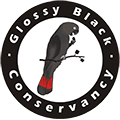The Glossy Black-Cockatoo, Calyptorhynchus lathami is one of Australia’s rarest cockatoos. At a size of only 45-50 cm in length they are the smallest Black-Cockatoo in Australia. The common name that refers to them as ‘Glossy’ can also be a little misleading, as they aren’t particularly Glossy in appearance at all.
Male Glossies have a more uniform brownish head colour, whereas the female Glossies have the distinctive speckles and irregular patches of yellow over her head and neck.
Colouration in the tail feathers is also characteristic but differs between the sexes and can vary by age. The tail panels in adult males have a bright solid red colour in their black tail.
In contrast, tails of adult females have more of a reddish-yellow panel separated by horizontal black barring. Not to be confused with other Black-Cockatoos, Glossies have a really broad bulbous bill, a small rounded crest and a much softer call than other Black-Cockatoos.
Did you know?
Glossy Black-Cockatoo, Calyptorhynchus lathami, are one of the more threatened species of cockatoo in Australia and are listed as vulnerable under QLD and NSW legislation.

Image by:
Threatened Species
There are 3 subspecies recognised across their distribution range with two of these occurring in QLD (see table).

C.lathami lathami is located in the South-Eastern corner of Queensland, Eastern and Northern New South Wales, extending slightly into Victoria with populations known in South Australia and Kangaroo Island. South East Queensland and Northern NSW is a stronghold for the species.
Feeding and Breeding
Glossy Black-Cockatoo have a very restricted diet, feeding only on the seeds in cones of she-oaks (Casuarina and Allocasuarina) and only on selected individual trees.
They are one of the friendliest birds and are not easily disturbed when feeding.
They will sit quietly and the only noise you will hear is the soft sound of cracking cones, people often do not even realise they are there.
In South-east Queensland Glossy Black-Cockatoos’ favoured food trees are the black she-oak (Allocasuarina littoralis) and forest she-oak (Allocasuarina torulosa). In the SEQ and northern NSW regions they have also been known to feed on C. cristata and C.equisetifolia.
They will return to the same food tree time and time again, often ignoring nearby trees that are full of cones, but these patterns of feeding are poorly understood.
They can fly more than 10km to feeding areas.
Breeding occurs every two years with a single egg being laid in late January to early June with a longer nestling period then any other cockatoos (up to 90 days). The young are dependent on the parents for at least 12 months.
Large hollow bearing trees are needed for breeding, emphazising the need to retain remnant vegetation in these areas just as much as food trees. Glossy Black-Cockatoo are known to have a life span that can exceed 30 years.
Our Partners




Glossies live here
Recent sightings of the Glossy Black-Cockatoos reported through the online portal
